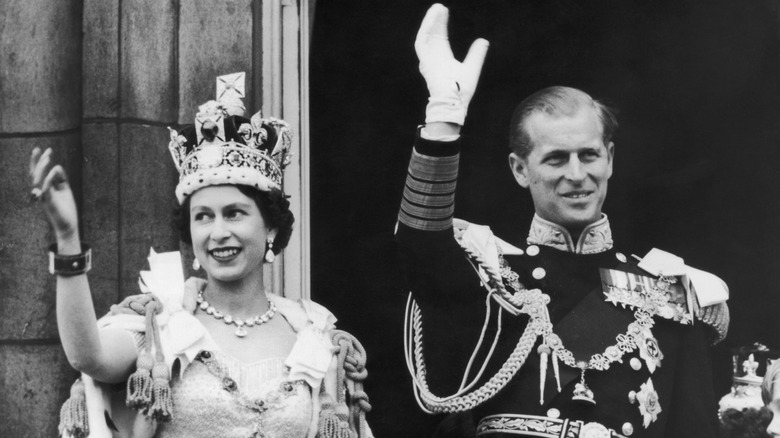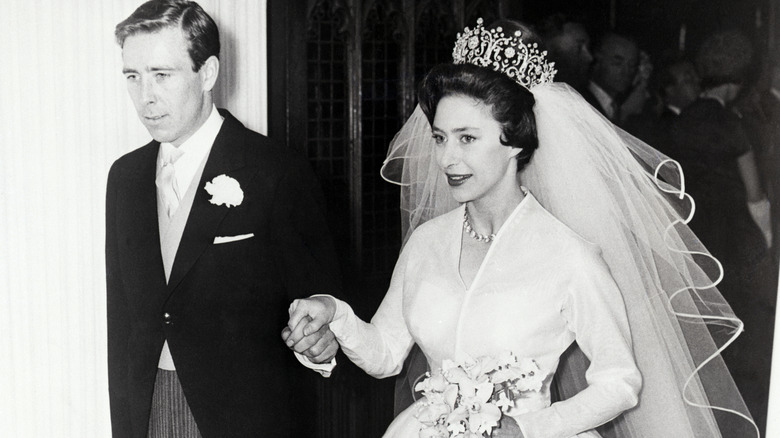The Secret Symbol Sewn Into Queen Elizabeth's Coronation Gown
For many women, their wedding dress is the most important and lavish dress they could ever hope to wear in their lifetimes. But if you're the Queen of England, there's one dress that usurps it — your coronation gown. The late Queen Elizabeth II was crowned in 1953. At the age of 27, she had already met and married the love of her life, Prince Philip, Duke of Edinburgh, meaning she had already worn a very ornate wedding dress.
It had a 15-foot train, pearl and diamanté-embellished roses, jasmine blossoms, ears of wheat and star flowers, and a becoming sweetheart neckline. The floral motifs were meant to symbolize Britain's rebirth and the great nation's fertility as it put the war firmly behind it. So when it came time to create the gown she would be crowned in, Her Majesty turned to the same dress designer who fashioned her stunning wedding day look.
And similarly, he incorporated a few more secret symbols into the gown, including a sweet good luck clover that would be mostly hidden from view but no doubt meant a great deal to the then-incoming monarch.
A clover for good luck
Miranda Holder, celebrity stylist, and royal fashion expert let slip a royal secret in her viral TikTok video explaining the secret good luck charm hidden in the dress's design. Sir Norman Hartnell, the designer behind the gown, was a firm favorite of the royal family, dating back to his role in creating a wedding gown for Princess Alice, the queen's aunt, in 1935. Over eight months, he crafted a regal, elegantly tiered, fit-and-flare gown that encapsulated the event's prominence while remaining demurely appropriate.
Emblems of the commonwealth were included alongside seed pearls and diamanté embellishments. Queen Elizabeth II was regularly kept abreast throughout the process, accepting or rejecting various design choices. But there is one element Hartnell didn't inform the queen about until the day she was slated to wear the gown. He embroidered an elegant four-leaf clover onto the skirt directly where the queen's left hand would lay during the ceremony.
A traditional symbol of good luck, the monarch was encouraged to touch the clover during the ceremony in a bid for the "most auspicious outcome," according to Holder. Thankfully, Her Majesty was enamored with the gown, calling it "glorious" and donning it again for the state openings of parliament during her Commonwealth tour a few months later.
The queen's favorite couturier
As the favorite couturier of the queen, Norman Hartnell didn't need much luck to go down in fashion history. The honor of creating the queen's coronation gown wasn't the first or even second time he had dressed her for a major event. In 1935, when Lady Alice Montagu Douglas Scott married the Duke of Gloucester, the son of King George V and Queen Mary, she asked Hartnell to create her dress and the bridesmaids' gowns too, one of whom was the future Queen Elizabeth II. He was granted a royal warrant in 1940, in time to design the late queen's wedding dress and those of her bridesmaids too.
In addition to Her Majesty's stunning wedding and coronation gowns, for decades afterward, Hartnell was regularly sought out by Britain's most famous family. In 1960, he designed the gowns for Princess Margaret's wedding to Antony Armstrong-Jones. Even though almost 100 feet of fabric was used for the skirt alone, Life magazine described it as the "simplest royal wedding gown in history," according to Town & Country.
Little did he know that the long-sleeved, relatively understated gown would go on to start a royal bridal trend. For the rest of his life, Hartnell continued bestowing his mesmerizing designs on the women of the royal family, being knighted for his work in 1977. Of all the dress-wearing royals, though, Hartnell especially found favor with Queen Elizabeth II, dressing her for two of the most pivotal moments in her life.

